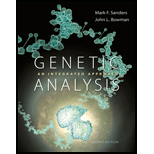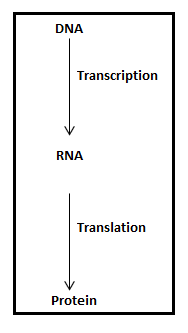
To analyze:
In terms of the central dogma of molecular biology, explain:
The meaning of biological terminology, “gene”?
The reason behind genes for rRNA and tRNA is considered to be genes even though they do not produce polypeptides.
Introduction:
DNA is the genetic material present in all organisms. Gene is a unit of heredity that transfers from parents to offsprings. In other terms, it is a physical and functional unit of heredity.
Central dogma – It is the directional flow of information from DNA to RNA to Protein. The process of copying DNA information into RNA is called Transcription while the process of translating the message copied into proteins is called Translation.
Explanation of Solution
Central dogma – It is the flow of the formation of a functional product that includes copying of genetic material into RNA and then the translation of copied sequence into proteins.

A unit of heredity that is passed from one generation to the next generation or from parents to offsprings is called a gene.
Genes instruct for a functional product or proteins according to the need of a cell. These proteins are joined together and form polypeptides. Genes that specify the polypeptides are called protein-coding genes.
Not all the genes specify polypeptides; some code for other molecules, too. Few genes instruct the production of RNA molecules like tRNA (Transfer RNA) and rRNA (Ribosomal RNA) that play crucial roles in the translation.
The gene is the structural and functional unit of DNA which transmit from one generation to the next generation. The gene contains necessary information for the formation of the specific protein.
Want to see more full solutions like this?
Chapter 8 Solutions
GENETIC ANALYSIS: AN INTEG. APP. W/MAS
- The figure below represents a cell undergoing gene expression. Use the figure to answer the questions that follow (a - e). a. What is indicated by label (2) in the figure above? b. What is indicated by label (3) in the figure above? c. What happens to the part labelled (3) and what complex makes it happen? d. Which amino acid is represented by (6)? e. Give the one anticodon in the 5' to 3' direction that will recognize all the codons for this amino acid in (c)arrow_forwarda. How can a single eukaryotic gene give rise to several different types of mRNA molecules?b. Excluding the possible rare polycistronic message,how can a single mRNA molecule in a eukaryoticcell produce proteins with different activities?arrow_forwardA molecular geneticist hopes to find a Gene in human liver cell that codes for an important blood-clotting protein,he knows that the nucleotide sequence of a small part of the Gene is GTGGACTGACA.briefly explain how to obtain genearrow_forward
- a. The reading frame DNA sequence is: b. The mRNA sequence is: c. The polypeptide sequence is: A disease in frogs which causes their tongue to fall out of their mouths is killing the frog population in LA County. You obtain a dead frog and isolate its gene Xf. When you sequence this mutated gene, you find that the last ‘G’ at the end of the first line of this sequence has been deleted (i.e. the G at position 86). In order to determine how this mutation changes the resulting polypeptide, write the mutated polypeptide sequence in the space below. What kind of mutation was produced? The mutated polypeptide sequence is What kind of mutation was produced?arrow_forwardConsider the following portion of mRNA produced by the normal order of DNA nucleotides: 5’ – CUU AAA CCA GUU – 3’ a. What is the template DNA sequence that was used to synthesize this portion of mRNA? b. What is the amino acid order produced from this mRNA? c. Write the amino acid sequence if a mutation changes CUU to CAU. Is this likely to affect protein function?arrow_forwardA molecular geneticist hopes to find a gene gene in human liver cells that codes for an important blood clotting protein. He knows that the nucleotides sequence of a small part of the gene is GTGGACTGACA. briefly explain how to obtain the desired genearrow_forward
- A molecular geneticist hopes to find a gene in human liver cells that codes for an important blood-clotting. He knows that the nucleotide sequence of a small part of the gene is GTGGACTGACA. Briefly explain how to obtain the desired gene.arrow_forwardBelow is a DNA sequence of the coding strand for a small gene. This gene has no introns. +1 5'- TATAAGATGCGTAGGATGCAGCTGTTTCAGCAGCCACGGTCTCGGCCCAGATAGCAGATAATAAACACGC GTA-3 a. Is this gene for an eukaryote or a prokaryote? Give one reason (. b. How many amino acids are expected to be coded by this gene? c. There are five underlined nucleotide sequences, interpret the purpose of three of them ONLY?arrow_forwardUse the Genetic Code below to help you answer the following questions. The nucleotide sequence of a hypothetical eukaryotic gene is: 3'- CCC CAT CAG TCA AGG GAA - 5' a. Provide the mRNA of the non-mutated gene. b. Provide the linear amino acid sequence of the non-mutated gene. üü c. Examine the mutated DNA sequence below. What would be the sequence of the mRNA? ü Mutated DNA sequence: 3' CCC CAC AGT CAA GGG AA 5' d. Provide the linear amino acid sequence of the mutated gene and identify the type of mutation. e. Comment on the consequences of this type of mutation?arrow_forward
- Complete each of the following statements by selecting from the bank of terms below. a. tRNA b. spontaneous c. repressible d. RNA processing e. mutagen f. SNRNA g. redundancy h. universal i. promoter j. elongation There are several three nucleotide codons that code for the same amino acid. This is known as (81). A specific three nucleotide codon for a fruit fly codes for the same amino acid as that same specific three nucleotide codon for a human. This means that the genetic code is (82). The three steps of transcription are initiation, (83), and termination. The (84) region on a chromosome is the sequence of nucleotides in DNA that indicates where the RNA polymerase complex should bind to initiate transcription. In a eukaryotic cell mRNA is modified in three ways. This is known as (85). The role of (86) is to combine with protein and then bind to introns to remove them and splice the RNA together. The role of (87) is to transport amino acids to the ribosome where the anticodon loop…arrow_forwarda. In your claim words, depict the contrast between ρ-dependent and ρ-independent end of translation in prokaryotes. b. If you have a given amino acid, can you be able to identify its RNA? Why or why not? c. How does mutation can affect the central dogma and the phenotype?arrow_forwardGive typing answer with explanation and conclusion Which description applies to alternative mRNA splicing? 1. heritable changes in gene expression that occur without altering the DNA sequence 2. processing of exons in mRNA that results in a single gene coding for multiple proteins 3. mRNA modifications such as additions of a 5′‑cap and 3′ poly‑A tail and removal of introns 4. a gene cluster controlled by a single promoter that transcribes to a single mRNA strand 5. protein modifications such as addition of a functional group or structural changes such as folding Answer 2 is correct.arrow_forward
 Human Anatomy & Physiology (11th Edition)BiologyISBN:9780134580999Author:Elaine N. Marieb, Katja N. HoehnPublisher:PEARSON
Human Anatomy & Physiology (11th Edition)BiologyISBN:9780134580999Author:Elaine N. Marieb, Katja N. HoehnPublisher:PEARSON Biology 2eBiologyISBN:9781947172517Author:Matthew Douglas, Jung Choi, Mary Ann ClarkPublisher:OpenStax
Biology 2eBiologyISBN:9781947172517Author:Matthew Douglas, Jung Choi, Mary Ann ClarkPublisher:OpenStax Anatomy & PhysiologyBiologyISBN:9781259398629Author:McKinley, Michael P., O'loughlin, Valerie Dean, Bidle, Theresa StouterPublisher:Mcgraw Hill Education,
Anatomy & PhysiologyBiologyISBN:9781259398629Author:McKinley, Michael P., O'loughlin, Valerie Dean, Bidle, Theresa StouterPublisher:Mcgraw Hill Education, Molecular Biology of the Cell (Sixth Edition)BiologyISBN:9780815344322Author:Bruce Alberts, Alexander D. Johnson, Julian Lewis, David Morgan, Martin Raff, Keith Roberts, Peter WalterPublisher:W. W. Norton & Company
Molecular Biology of the Cell (Sixth Edition)BiologyISBN:9780815344322Author:Bruce Alberts, Alexander D. Johnson, Julian Lewis, David Morgan, Martin Raff, Keith Roberts, Peter WalterPublisher:W. W. Norton & Company Laboratory Manual For Human Anatomy & PhysiologyBiologyISBN:9781260159363Author:Martin, Terry R., Prentice-craver, CynthiaPublisher:McGraw-Hill Publishing Co.
Laboratory Manual For Human Anatomy & PhysiologyBiologyISBN:9781260159363Author:Martin, Terry R., Prentice-craver, CynthiaPublisher:McGraw-Hill Publishing Co. Inquiry Into Life (16th Edition)BiologyISBN:9781260231700Author:Sylvia S. Mader, Michael WindelspechtPublisher:McGraw Hill Education
Inquiry Into Life (16th Edition)BiologyISBN:9781260231700Author:Sylvia S. Mader, Michael WindelspechtPublisher:McGraw Hill Education





